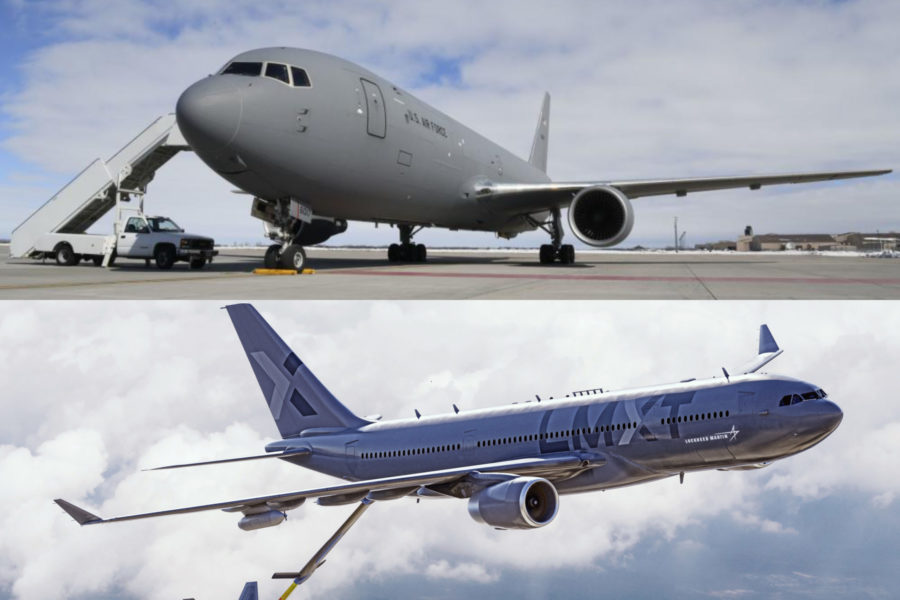DAYTON, Ohio—What is now officially known as the KC-135 Tanker Recapitalization Program—formerly called KC-Y or the “bridge tanker”—should clear the Pentagon’s joint requirements process by the end of September, at which time the Air Force will issue a Request for Information to industry for potential solutions, Scott Boyd, USAF’s deputy program manager for mobility aircraft, told reporters July 31.
However, Boyd said the service is not yet ready to discuss the timing and exact number of aircraft in the program, as much of that will depend on the success and timing of the Next Generation Air-refueling System, or NGAS, which will come after it.
The Air Force will complete an acquisition strategy for the KC-135 recap tanker in the third quarter of fiscal 2024, he added. It will be based on an analysis of alternatives that will also launch this fall.
The KC-135 recap effort should complete the Joint Capabilities Integration and Development System (JCIDS) process next month. Around the same time, the RFI will be published, Boyd said during Air Force Materiel Command’s annual Life Cycle Industry Days conference.
“As soon as I get a systems requirement document,” the program will get underway, Boyd said. It will be the first official requirements statement for the program and will translate the requirements “into the language of industry,” he said. No additional time will be needed to write the RFI because the Air Force already has all the information that went into the requirements and no changes are expected, he said. Responses to the RFI would be due next year.
Boyd said “nothing has changed” with regard to the KC-135 recap, in that no particular airplane has been ruled in or out. Senior Air Force leaders have said they are leaning toward buying more KC-46s from Boeing as the KC-135 recap, but Boyd said the Air Force still has time to do “market research.”
Lockheed Martin is offering USAF a tanker based on the Airbus A330 Multi-Role Tanker Transport dubbed LMXT, and company officials have argued NGAS will likely not be ready by 2035, the Air Force’s target date.
When NGAS enters the fleet will affect how many tankers the Air Force buy as part of the KC-135 recap program, Boyd noted.
Air Force Secretary Frank Kendall says the service needs to get the NGAS as soon as possible. The original plan called for the future tanker—expected to be small, stealthy, and capable of accompanying combat aircraft in contested airspace—around 2040, but Kendall has “dramatically pulled that in and said ‘no, we need to go faster because it’s that NGAS capability … that scares China,” Boyd said.
With that updated NGAS schedule, Air Force acquisition executive Andrew Hunter said in March he thinks the KC-135 recap program will consist of around 75 airplanes, after the service had previously said it might buy 150. Lockheed officials, on the other hand, have suggested 2040 is a more realistic timeline for NGAS, which would necessitate more KC-135 recap tankers.
While Kendall and Hunter have hinted they may simply opt for more KC-46s instead of a tanker competition, some lawmakers from states where Lockheed would assemble its LMXT offering have tried to mandate competition through legislation.
Despite all this, “I’ve honestly not felt pressure from Congress or from within the Air Force to do anything different than what we were already doing,” Boyd said.
In response to questions from reporters, Boyd also offered little indication whether the forthcoming requirements will tip the program toward the KC-46 or LMXT. He said the JCIDS document for the recapitalization program will not include anything “revolutionary” and could “potentially be satisfied” by continued buys of KC-46s.
On the other hand, he also noted the document “is not going to declare that we cannot create a new logistics” tail for the airplane to be acquired—which LMXT would require, because there is no similar airplane in USAF’s inventory.
“It may speak to sustainability of the weapon system in ways that tell you that I probably don’t want to create a new [logistics and support train], but it’s not going to be clear that you can’t,” Boyd said. “It’s going to come down [to] … the business case analysis that we’re doing, and the final market research that we do to decide what is the best value approach for the Air Force. And that’ll be our recommendation.”
There will also be lessons learned from the KC-46’s troubled development—Boeing agreed to a fixed-price development and production program on the KC-46, but so far has borne more than $7 billion in overages on the project—that will apply to the new tanker program, noted Col. Leigh Ottati, chief of the KC-46 program office.
“Everyone needs to understand” the scope of a program like a new tanker, said Ottati. The KC-46, originally thought to be a simple conversion of a cargo jet into a tanker, turned out to be “more development than everyone thought,” and Boyd said that lesson will be front of mind as the Air Force pursues the KC-135 recap and NGAS.
Industry and government need to both understand “the scope of what’s being asked,” he said.
